#I even made Yiga themed dividers
Text
Listen. For Sooga, I become this creative person. 🤌🏼🩷
#i love that man so much#like 😭😭😭#sooga#I’m probably going to make up more hc’s as the story progresses#but for now enjoy#I even made Yiga themed dividers#they’re all crooked but fuck it
0 notes
Text
PLAYING: The Legend of Zelda: Age of Calamity
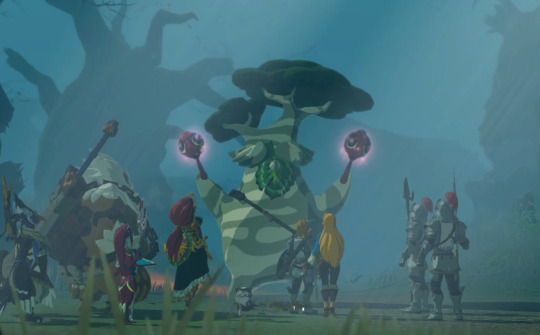
It is what it is and it keeps being that.
I'm not super stoked about this game right now. Not that it's bad. It's fun, it's simple, and has things to do. But what I really wanted from this game (besides a Zelda-Themed Dynasty Warriors) was an engaging backstory to Breath of the Wild. And this just isn't it. Really, I'd say this game barely rehashes the flash backs of BotW while failing to add significant plot of character. Maybe that's intentional. Maybe Nintendo didn't want Omega Force taking too many liberties that might conflict with their own plans for Zelda.
I'm moving forward in the story missions, though slowly. I'm happily playing all the side quests and trying to unlock all the extras. I like how the levels take place in the open world map, but they've been designed as narrow hallways instead of wide open spaces. That and the camera fail to make me feel like I'm in this large world. Instead, every level feels like a generic representation of a broad area. Even the Zora Domain hardly stands out as anything unique.
Something I believe I forgot to mention was the Divine Beast levels. My son loves these levels. There's not much of a challenge to them and you have minimal freedom to move around, but given you hardly saw the Divine Beasts in action before it's exciting to have included these piloting levels.
Part of the issue is there's no real plot to follow. Enemies appear in different areas of the world map and you fight them. It would have been interesting to approach the game like Empires. Divide the world map into 16 or so regions. Clearly show which are enemy "controlled" and which are not. Then show the shifting tides as you progress. Give plays a choice between 2-4 missions. While success in one area may clear the zone, you can then see monsters advance in other areas. And then the difficulty could be increased with a logical explanation.
Instead, I there's a mission here and there, and sometimes it's monsters and sometimes it's Yiga clan...I don't know.
It's a fun, well made game, but I'm not getting as much as I wanted out of it.
#Zach's Game Journal#PLAYING#The Legend of Zelda: Age of Calamity#Nintendo Switch#Video Games#Gaming
1 note
·
View note
Text
Undeath in the Era of the Hero of Time : 1
aka Seeing the Hero’s Shade in this TP replay shook up all my feelings of agony again and now I’m working backwards from there because I like to hurt myself.
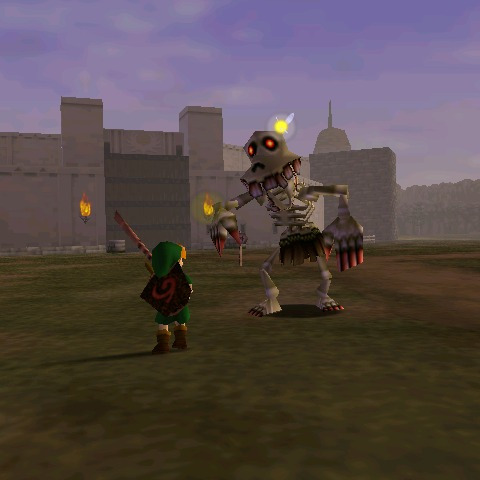
Part One: An Overview of How Fucked Things Are ™
aka The Blood Soaked Hyrule of OoT’s time
Take it as you will, in the Zeldaverse, the colour green has an overwhelming association with undeath.
Sure, sure, life too, I hear you. Farore came down and produced all the living beings that would uphold the law, apparently (specifically not claiming monsters and demons, but that’s another thing). On the surface, that make sense. Forests, lush green fields, prosperity, all of those good things. Green the colour of the most common rupee, green the colour of the Hero’s tunic. Green the colour of magic, and potions that revitalise the body and spirit.
The thing is, revitalising the body and spirit is a flexible idea. To imbue something with new life and vitality can have a lot of implications, especially when you stop talking about the strictly living.
I feel vitality is certainly the best word, not only because of it’s association with life and potency ala the Goddess origin stories, but in the ways that the game uses green itself, such as a measure of both magic and stamina. Green is the colour chosen to represent the unlocked potential within young Heroes.
Vitality specifically refers to a state of being strong and active, and it also refers to the continuance of something to exist. That’s a great thing for plants, or economies, or a potion taken by a young Link who’s swung their sword around or fired off a spell one too many times and feels a little low.
But the dead, though?
As it happens, Hyrule is absolutely littered with human remains, in no small part due to the very recently ended civil wars.
The Civil War, if you need the reminder, is described as a time when the many races of Hyrule were divided and each focused on establishing dominion over the Sacred Realm (because Triforce). I touched on this in my last meta post, but basically, its no holds barred to stop that from happening because if the wrong person gets into the Sacred Realm and makes a wish, it immediately malfunctions.
The criteria for getting into the Sacred Realm and touching the Triforce without royally fucking everything, is basically impossible for anybody not chosen by Hylia.
If you are neither of Hylia’s Bloodline (The Hyrulean Royal Family) or one of her Chosen Avatars (The current incarnation of the Hero), you are not supposed to touch the Triforce. Ever. You WILL be found wanting, it WILL shatter, the Sacred Realm WILL be corrupted by your selfish desires, it WILL unleash and onslaught of mystical influence (reflecting your heart) onto the country.
Now, if it’s Zelda or Link who touches it, that’s fine. Good vibes will pour out. An age of prosperity will ensue. The Sacred Realm is in its default state, a blank and neutral wellspring of magical force.
The game has been rigged from the get go because Hylia still had a job to do. She had to get creative because Demise almost captured the flag, so to speak, leading to the snafu of the Cycle and all that because she cheated at the game, but ultimately Hylia’s task was to guard the Triforce. And that still remains true, for the most part. The Hyrulian Royal Family (and the Shiekah by extension) had to stop at absolutely nothing to win the wars and unify the country, and retain the stasis of the Realm and Triforce, because that’s what their divine orders are.
That’s what they’re supposed to do, ‘the very reason that they’re born’, to lend a quote from King Daphnes. With Hylia on their side by default, they’re willing to do a lot of fucked up things to make sure that happens, ‘for the greater good’.
These dark times are a result of our deeds... -- TP Zelda
In OoT The Sheikah are known as the Shadow Folk. They are heavily associated with death, whether that is caring for the dead’s rest in the graveyard, or working as spies and assassins on behalf of the Royals, or dabbling in various forms of necromancy. Red eyes are an established trait of their people. I will note that, at least from a Japanese point of view, red is often used with the intention of intimidating evil spirits. But it is also a color identified with power and vitality.
So, one could suppose, the Sheikah red eye also symbolises power/control over evil and darkness (spiritually).
That’s a little something that plays nicely with things like the OoT Manga’s explanation of the tear on the eye (and the previous betrayal of the Royal family) and the high probability of a Shiekah faction defaulting during the wars and being banished with other traitors to become the Twili. I know the manga isn’t canon and also SS Impa has a tear, but if you squint, that might be because of her own feelings of personal failure to the Goddess after Hylia’s shedding of her Divinity. You could headcanon that. The existence of the Yiga later in BoTW as a similar happening of division and betrayal lend some more weight to things.
Also, Sheikah who defaulted during the civil war might have even been the ones who actually utilised the Shadow Temple.
Headline: Necromancer ninjas in the process of torturing enough info out of the enemies of the Royal family, who were reportedly seeking the Sacred Realm, decide ‘hey fuck it, let’s take it ourselves’.
That certainly fits into the description of, ‘interloper skilled with dark magic started to appear, seeking dominion of the Sacred Realm’, for me.
Anyway, to the point.
In ostensibly one of the most haunted areas of the game, Kakariko village, we’re treated to the Graveyard and the Royal Family’s Tomb, the Shadow Temple, and the Bottom of the Well. All of these showcase the obvious death and torture that went on, as well as the creepy byproducts of places so saturated with blood, pain, regret, and hatred.

There are skulls in little alcoves on the walls of the catacombs, literally built of bones, who deliver messages to Link. The ones that whisper these messages are all marked by the glowing green eye sockets. Here, the green is used to make the presence of a ghostly sentience inhabiting the skull.
Unsettling. Musty. 4/10 heebie-jeebies.

The Deadhand, giver of childhood trauma that it is, really does its job to hammer home the fact that there has been so many deaths, so much anguish and horror, that those remains can seemingly form into entirely new monstrosities. An amalgamate of undead flesh and nightmare fuel, made up of the body parts of torture victims and the grudges of lingering spirits, seeking to consume the living vitality of whatever comes near-- Link wearing green around the thing might as well be red to a bull.
When defeated in game, it typically drops a small green pot that refuels Link’s magic.
This is a common theme with undead enemies, specifically the ones that are of the zombie flavour. Redeads, Gibdos, Deadhands. All of them generally give up, effectively, distilled magic as a drop item.
Terrifying. Probably smells even worse. 11/10 heebie-jeebies.
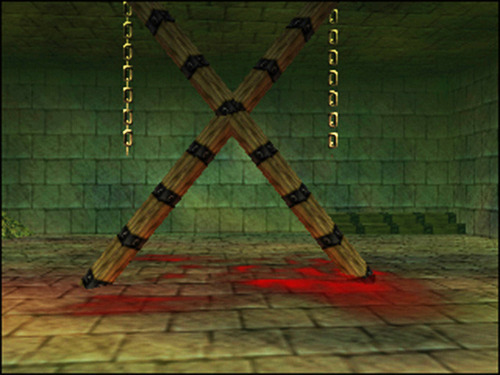
Literal torture device. So many people died here, the room has a green tinge to it. It is soaked in the spiritual imprint of the pain and anguish that took place here. Blood sits here looking freshly spilled, despite the civil war ending many years prior and the Shiekah having ‘died out’, save Impa.
Elsewhere in the temple and under the well, blood splatters are darker red and at least have the decency to pretend to be old. This means one of two things:
Impa still has to make sacrifices to the Seal that contains Bongo Bongo, or feeds people to the undead creatures who lurk down in the dark so they don’t wander up. (Cue the gasp of ‘so that’s why she let the Hylians into Kakariko! Every so often one of them goes missing!’)
Which is a fun dark headcanon to play with, but probably not the case.
Or more likely, the residual spiritual energy that the green haze suggests manifests fresh blood in a manner typical of extreme hauntings. For the victims, their hatred and pain persists so strongly, that their blood seeps up from the cracks no matter how long it has been.
Poltergeist shit. Slip hazard. 8/10 heebie-jeebies.
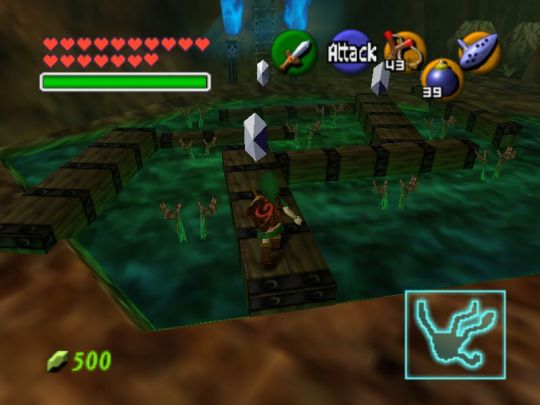
Then there is this. Some people say its just another torture thing, it could have been intended to convey some sort of acid dip. If not torture, maybe bodily disposal. And sure, that’s a reasonable guess.
But it is at the very bottom most cavern of the Well of Three Features, and if it were acid-- for how long the bodies have just been marinating in it-- you can assume nothing would be left of them to stick out. And the fact that all the bodies are neatly spaced, with the arms oddly preserved. They’re presumably like that from lowering bodies in from the wooden beams, the victims may have been tied up with their arms straight upwards.
But, given the Redeads wandering around nearby, I’m pretty sure that’s what this thing does. Make Redeads.
The liquid itself hurts Link, but Link is also alive, and this pool seems to be lacking much of a glow. It’s green, sure, but it’s not exactly teeming with energy. And I think that might be part of its designated purpose-- extracting that green vital energy from living prisoners, draining them until they’re dead. I’m talking juicing people and scooping out the good stuff like the pulp from a really disturbing OJ.
But still steeped in the juice as a corpse, you’re basically pickled in magic brine, so then those gross husks crawl out as Redeads. (Hey, you know what’s handy in wartime? Scaring the shit out of enemy forces by sending some zombies at them. And if they kill them, you’ve lost nothing. If the Sheikah could actually control them? Undead soldiers. Excellent stuff.)
But all the pulpy good stuff is gone, and has been for a while, so most of the bodies in there haven’t pickled in enough magic to reanimate, I suppose.
Human juicer that churns out zombies. Out of juice currently. 6/10 heebie-jeebies.
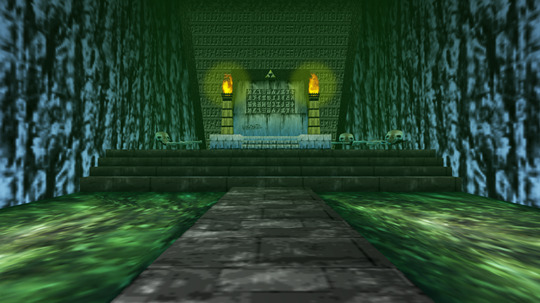
Now, THIS is active zombie juice, if I’ve ever seen it.
This is the Royal Family’s Tomb, by the way. Note the skeletons, picked clean, missing a lot of bones. And that’s a choice they made, because there are also full skeletons around to find.
There are plenty of Redeads down there, for good measure, so I’m going to assume the skeletons are potential graverobbers who were eaten. If Sheikah can presumably command the dead, then the Redeads down there might actually be a counter measure against thieves. If a thief freaks out in the dark when he realises there’s undead down there trying to eat their face, there is also a good likelihood they’ll trip and splash into this green death. A few seconds of exposure is probably enough to kill the average person, and then if their corpse stews for a bit, you have another Redead.
Their living energy revitalises the goop. Their body becomes bolstered security measures. It’s a self sustaining system.
Horrific but effective. 5/10 heebie-jeebies.
Also, there’s a chance that a couple of the skeletons or one or two Redeads down there are the remains of the Composer Brothers. But they will get their own special part in this series, covering Poes in particular.
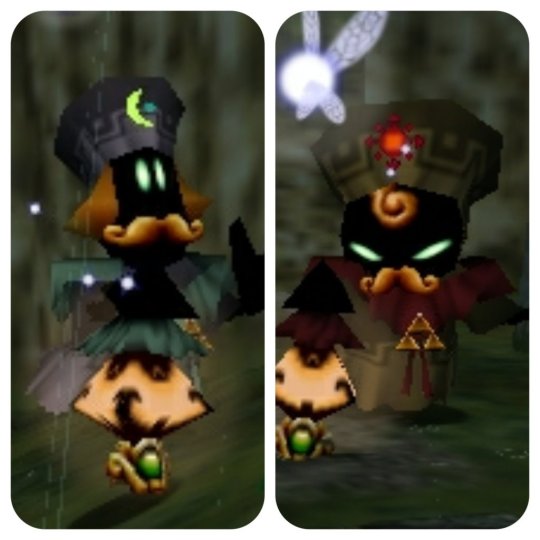
But for the moment, let it be noted: their eyes are also that ghostly green.
Poes are spirits that are unable to move on and who have the unfortunate fate, if left unattended, of turning into phantom monsters who forget their human selves and prey on the living. They tend to pop up the most in two places. One, the Kakariko Graveyard, is obvious and somewhat expected. Dead people, lots of lingering spirits, most of them probably Sheikah and Knights of renown who died in the line of duty. Understandable.
So when you apply the same thought to the fact that Hyrule field is the second most common place to find them, you may as well be concluding that it’s an enormous mass grave of war casualties.
We have established that mass quantities of concentrated death, especially earth that is saturated by the spilled blood of strong soldiers and highly skilled warriors (full of life and magic, as it were), can result in creepy shit made from human remains reanimating over time.
Poes share their haunting of the field with these bumpkins:

These hauntings are not the result of Ganondorf, or the corruption of the Sacred realm. They are not a particular curse placed by anybody.
The Poes and Stalfolk are present in the game from the very beginning, and quite normal fare for Hyrulean life. Lon Lon ranch and castle town are walled off for good reason, and the drawbridge raises at night specifically in response to the literal skeleton monsters who roam around at night.
Stalchildren, specifically, seem akin to the Deadhand in that they are not a direct reanimation of any one particular set of remains. Rather, they seem to be mutated amalgamations of various parts. In the case of the Stalchildren, they rise up under the dark of night, a not-quite-human formation of bone and magic. They seem to possess an aimless drive to attack, perhaps possessed still by the orders of the soldiers who died there.
Interestingly, in a somewhat similar fashion to BotW’s blood moon reanimating the fallen monsters (due to the potency of Malice in the land peaking at those times), Stalchildren only seem to be active under the moonlight. They disintegrate when the sunlight touches them, which promotes the idea that they are the bones of the fallen possessed by the ghostly memory of the war.

They also appear to wear raggy leather kilts, which is a feature they share with the related monster, the Stalfos, who are often acting out the part of a soldier as well. Even better, those bastards are actually WEARING GREEN, to boot, which given the history of Hyrulean Knights prior and their uniforms (SS and Minish cap) is pretty self evident.
Stalfos, however, are also confirmed as humans who have died under certain unique circumstance (such as the magical influences of the Lost Woods) and reanimated as a consequence of what I assume is basically magic poisoning.
It could be a bit like an overdose, succumbing under the intense mystical forces at play within proximity to the Deku Tree (which the strong of spirit can resist). It could be a draining effect, maybe even just a gaseous version of what’s happening when people come into contact with the green goo, except extracted by the forest spirits and plants (also possible that the strong of spirit might resist). That could go either way.
The forest absolutely does eat people’s spiritual energy, though. RIP to Grog and Link’s mother. They’re Stalfos now.
"Anybody who comes into the forest will be lost. Everybody will become a Stalfos. Everybody, Stalfos."
Upon killing both kind of Stal, however, the bones rapidly deteriorate into flames.
You guessed it: green.
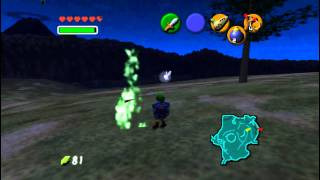
I’ve already pointed out a BoTW reference already, but to add more context back into this thing about the tie between green and things in Hyrule that refuse to die properly:
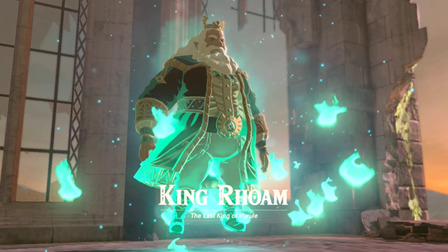
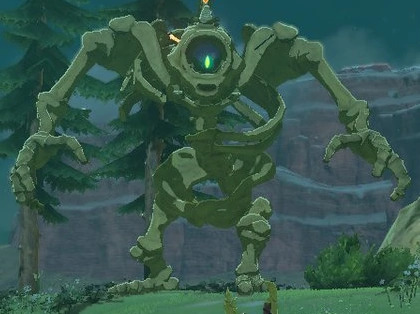
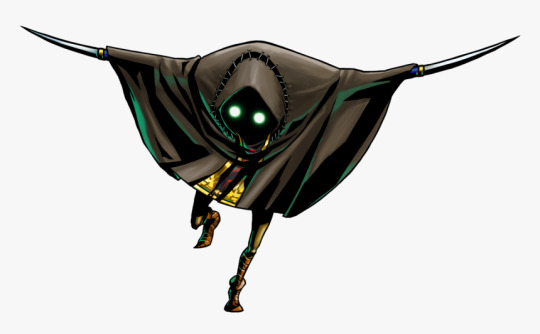

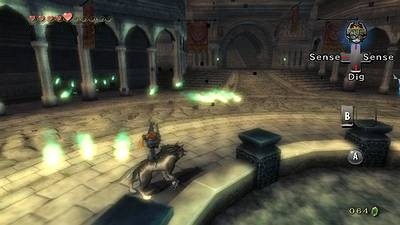

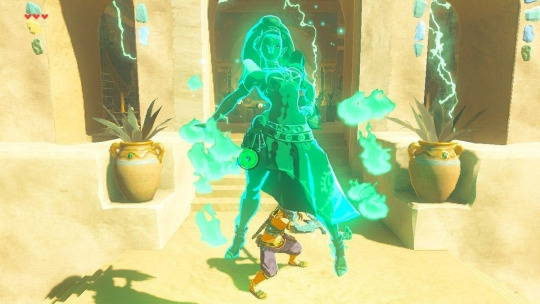
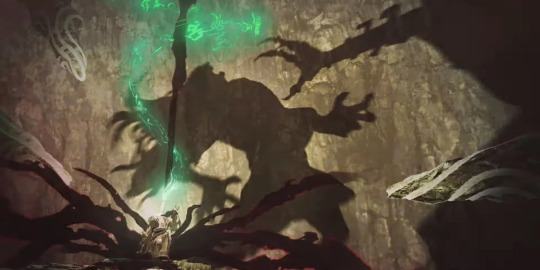

That last one is cheap of me I’m sorry but we’ll get to him too
So we have established that green has an overwhelming association with not only life, but states of undeath.
The overview is, things were already pretty fucked in OoT Era before Ganondorf got the Triforce.
On to part 2!
#tloz#legend of zelda ocarina#Ocarina of time#link#zelda lore#zelda meta#zelda theory#zelda theories#zelda discussion#death tw#blood tw#shadow temple#shiekah#stalfos#poes#undead tw#long post#hero of time#hyrulean history
42 notes
·
View notes
Note
My question is basically: in the scenario I describe, do you think I should go with or without torture as a referenced thing that happened? The situation is this- my character’s father has been dead for seven years, but I thought that what if, instead of being killed by the monster he was faced with at the time, he was injured by it and then captured by a group of bad guys. This is set in the Legend of Zelda: Breath of the Wild universe and the bad guys in question are the Yiga Clan, (1/9)
who alternate between a comical and threatening presence in the game. They are presented as a tribe of assassins, but the reason why they decide to take my character’s father alive is that they saw him using a rare kind of magic and either want him to teach it to them or want to get him to use it for them. (It’s hereditary so he can’t teach it to anyone but his daughter, but they don’t know that and he will neglect to inform them that anyone else has the same abilities.) (2/9) Most likely they want him to do something with his magic when their idol (Ganon, The Big Bad) returns or possibly something that they think would help him return. Where the question of torture comes in is, I need him to still be alive and capable of going with an escape attempt after seven years. So, whether or not they get the notion to try torturing at any point, it obviously can’t be super regular or prolonged over this period. I thought maybe one or two incidents toward the beginning (3/9) of his captivity, which were ordered to stop when they realized they would have to keep him alive for an undetermined amount of time and that’s easier when you aren’t treating extra injuries, but I’m not sure that would really add anything other than acknowledging the fact that someone in there probably got the notion to go “hey if he won’t teach us that magic what if we punch him and ask again” and may not have been turned down. Or they may have, (4/9) or they may not have brought it up at all because the Leader didn’t ask them to. Alternately, I could lean into their comical side and say that, while they got the idea to try “torturing” they don’t actually know how to do that. They’re assassins, they usually just kill, they don’t really know what to do with prisoners, it’s been a long time since they split off from another group that may have known torture techniques in the service of the now-destroyed kingdom. In which case it would be (5/9) things like “ohoho what if we give him his food... WITHOUT ANY bananas? he’ll be MISERABLE” (they are obsessed with bananas) played for a weird kind of humor. On the other hand I don’t want to imply that if they’d tried “REAL” torture it might have worked. Possibly the punching and asking again was tried once toward the beginning, then the comical “no bananas” one was tried later and neither one accomplished anything? I don’t want to say he spent seven years underground (6/9) surrounded by a comical murderous weirdo cult and “nothing really happened” in that time until his rescue but I don’t want to shoe in something like Actual Torture Attempts when it isn’t necessary. I could fill his time with escape attempts and/or trying to get information. Final thing: his daughter is going to break him out with the help of the Hero and a friend who defected from the Yiga Clan. This friend’s mother is going to take leadership of the clan but is meant to reform somewhat. (7/9) My character (the one whose father is imprisoned) could funnel her anger at his imprisonment towards the previous leader but if she finds out he was tortured (or weird attempts were made at it) she could have more trouble coming to a grudging, still pretty angry acceptance that her friend’s mother exists and is the way she is and probably shouldn’t be magically lit on fire. Or she could compartmentalize and say the friend’s mother never ordered anything like that, or may have even (8/9) turned a blind eye to her father’s final escape. This was a lot of detail but again the main questions are: does that seem like torture attempts would add or detract, and would it be in poor taste to include something like the “no bananas” scene? (9/9)
-
While I’d never played a Zelda game when I got this ask I am now one of Those People who got a switch in response to not being able to go outside. (They had pokemon, I was weak). And I’ve put a lot of hours into Breath of the Wild since. It’s a beautifully realised setting and I can see the appeal of writing something set in that world.
Humour is a very subjective thing. Whatever we do there are always going to be people that the jokes don’t land for. I’ve (mostly) got positive responses to my humour but I have had incidents both here and on my AO3 page where people took exception to it. And that’s a lot more likely to happen when we’re dealing with serious topics.
That said, I do think that we need humour about the things that scare us. There’s nothing quite as potent and satisfying as making our fears ridiculous.
If you’re considering using humour in a torture/kidnap/POW situation (whatever you decide re torture the story definitely contains some of these elements) then the main thing to consider is this: what are we actually laughing at?
This kind of humour is mostly likely to backfire or be outright hurtful when it can be interpreted as laughing at the victims. Or at the existence of traumatic events. And it’s most likely to work consistently when it’s aimed at the abusers.
From the way you’ve described this it sounds like the joke is on the Yiga clan. As it is in the game itself. (I have enjoyed the assassination attempts by enraged ‘banana salesmen’.) If you wanted to continue the pattern the game set I think a lot of fellow fans would enjoy this humour.
But the main question here is about when we should use torture in a story. And how we judge whether it’s adding anything.
Personally I start by thinking about the tone and themes of the story. The kind of atmosphere I want to capture and kinds of character interactions I want to write.
Then I try to think through the impact torture would have on the narrative in terms of knock on effects. So, symptoms in victims/survivors, witnesses and torturers but also effects on culture, community and organisations.
It would probably be easiest for me to break this down with an example or two.
I’ve talked briefly about both of these stories before. One of them takes place about two decades after a military coup ousted an absolute monarchy. Ilāra, one of the major characters, was embedded in the old regime and tortured people. They were also tortured by the regime and helped make the coup successful.
And part of the impact torture has on the story is in Ilāra's symptoms. But it’s also in the way other characters relate to them. Normal people are afraid of them or disgusted/enraged at the sight of them. They’re ostracised by their own community and treated with contempt by their military superiors.
One of the major themes running through the story is the question of how we deal with people we love when they’ve done horrific things. And how countries, cultures, move on from atrocities.
Most of the major characters aren’t Ilāra's generation, they’re the kids who came afterwards. The people who just about remember the Revolt but grew up in a world without the monarchy. They’re navigating a legacy of blood and bitterness, things that aren’t their fault but nevertheless have shaped the world they live in.
Part of it is about how the children Ilāra helped raise respond to this personal (and national) history. How they try to square the fact that this person was good (and in some ways defining) for them, while being monstrous to others.
I felt that torture would add to this story because the point of it is those fault lines. In society at large and in personal relationships. It’s about exploring how we try to bridge or heal those fault lines and how, sometimes, we make them deeper.
Torture (and indeed the other atrocities that are part of the country’s legacy) serve to raise the stakes. They deepen that initial emotional trench between the characters. And they also… Pull the camera back I suppose? The story may be about a single family but it isn’t an individual story. It’s about how larger patterns of abuse effect everyone in a society. Torture serves to make it about the culture, the country, instead of just the individuals within it.
There are similar ideas in the other story I’m working on, societal divides and how we bridge them, but I think there’s a slightly different focus.
Both of these stories are fantasy stories, but while Ilāra's story is in a sort of circa 1900s past Kibwe’s is in the future. It’s extrapolating the political oppression and systems from the places I’m interested in (in this case India, the Philippines, Kenya and Nigeria.)
The story takes place across generations starting when Kibwe was a teenager but continuing to his daughter’s formative years and into his children becoming independent adults.
And there’s torture in this story because the entire family is involved in politics. Because I grew up knowing that the natural consequence of acting for major political reform/justice was arrest and torture.
The story is about trying to change unjust systems and generational violence. It’s also about the unhealthy ways people can engage in activism, putting the theoretical good of the community above their health and their families/friends.
I didn’t really have to think about including torture in any depth, it was a natural fit. In fact I’m not sure I could talk about politics in any meaningful way without talking about torture.
So some more specific questions that might help with your story. Is the structure of the Yiga clan important to the story? Is the effect they have on society at large important to the story? Is this primarily an individual/personal story or one with a wider focus?
There aren’t ‘wrong’ answers to those questions, it’s about what you want to write.
Do you want a more personal focus with the relationships between the major characters being more important then the world at large? I think of this as a character focused (as opposed to a character driven) story.
For instance in the Lord of the Rings trilogy while we care about every member of the fellowship the important thing throughout, the focus, is the destruction of the ring and the systems that are harming all of Middle Earth. By contrast in Howl’s Moving Castle we care about the war and the fate of the missing Prince, but the important thing is what happens to the girls from the hat shop.
Both of these approaches to a story can include torture in a meaningful way. It can add to both kinds of stories. But it’s generally adding different things.
In a character focused story (with the kind of plot you’re writing) torture is mostly adding a sudden change to all of the relationships a character has. There might be focus on symptoms, a recovery arc, character development etc but the first and most obvious thing it’s adding is a major change to how these characters interact.
In a story that’s more focused on the big picture of the world torture can add world building elements and it can be used to map out divisions and allegiances in the societies you write.
Part of the reason I’m making this distinction is that in this scenario you can very easily tell a character focused story with trauma-recovery and not have torture. Kidnap and seven years imprisonment is enough to be traumatising.
That doesn’t mean torture couldn’t/wouldn’t add anything to that story. But it might not be necessary for the story you want to tell and the focus you want it to have.
On the other hand if this is primarily a broader story about communities and cultures growing and changing, the decision of whether or not to include torture has much more potential to direct the plot. It could create opposition to reforming the Yiga clan, both inside the clan (wanting to stick with how things are) and outside it (with people wanting it utterly destroyed).
Different factions and cultures might band together on the basis of shared opposition to the Yiga clan. And the clan’s reformation could effect those allegiances.
There could also be knock on effects based on where the clan operates: cultures that have been targetted by them in the past might not want this new ‘reformed’ (and more obvious) Yiga clan on their lands. And that in turn could stir up trouble within the clan because hey they’ve been here for generations it’s their home too!
There are lots of ways torture could add to this plot and these characters. It could also feed in to broader themes.
For instance the main character and her father haven’t seen each other for seven years. The difference between how we remember or idolise someone and the way they actually are is a theme you could add to here. The Yiga clan is going to end up reformed: what does it take for people to accept that reformation and forgive? The main character is friends with a former Yiga assassin: how do we process the fact people we care about might have hurt others?
That isn’t an exhaustive list, I’m just throwing out ideas to see if anything interests you.
In terms of timing and character being physically able to escape I think you’re already hit on a pretty good idea.
Torturers don’t tend to stop when ordered to. Part of the reason a lot of organisations reject torturers is because they… tend to disobey orders. A lot.
So if you wanted to write a scenario where this character is initially tortured and then held for a much longer time without torture the realistic way to do that is to have the character transferred from the ‘care’ of one group of Yigas to another. Torturers tend to exist in groups as sub-cultures within larger organisations. Which means that their presence in an organisation does not necessarily indicate that everyone in the organisation supports/carries out torture.
You could even have the Yiga’s take a (perhaps half-hearted) anti-torture stance and have them punish the torturers.
Wrapping up, the decision of whether or not to include torture is up to you. I can see ways it could add to your story but the points and themes I’ve spoken about might not be things you’re interested in.
Just because an element could add to a story doesn’t necessarily mean it’s adding something you want. There’s nothing wrong with deciding that an element doesn’t interest you, takes the story in a direction you like less or causes more stress then you want as you write it.
Ultimately the question is whether you want to write torture. And there’s no wrong answer to that question.
I hope that helps. :)
Available on Wordpress.
Disclaimer
#lia-wild-english#writing advice#tw torture#tw kidnap#writing survivors#writing torturers#effects of torture#effects of torture on society#worldbuilding#fantasy ask#torture survivors and relationships
15 notes
·
View notes